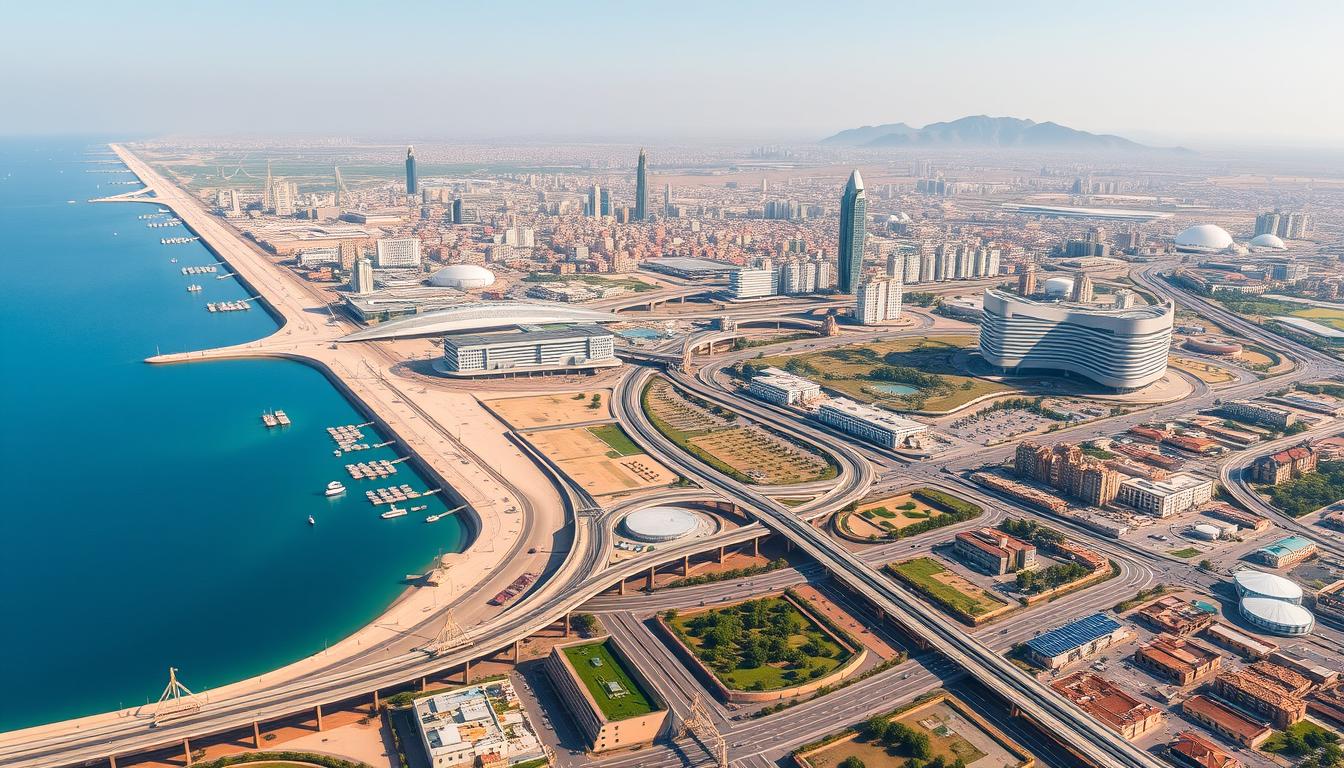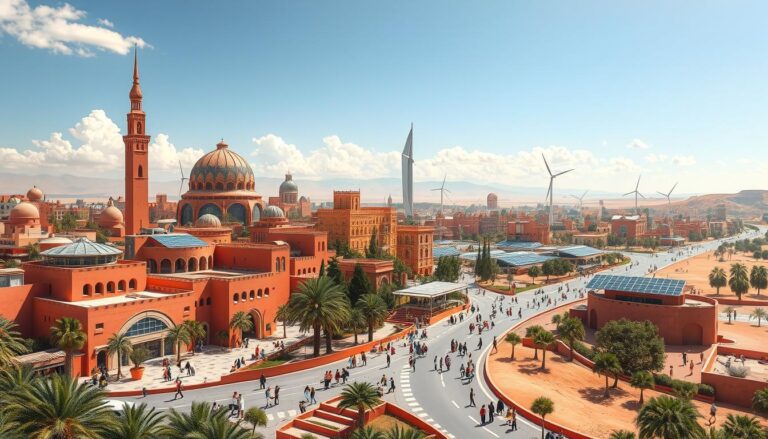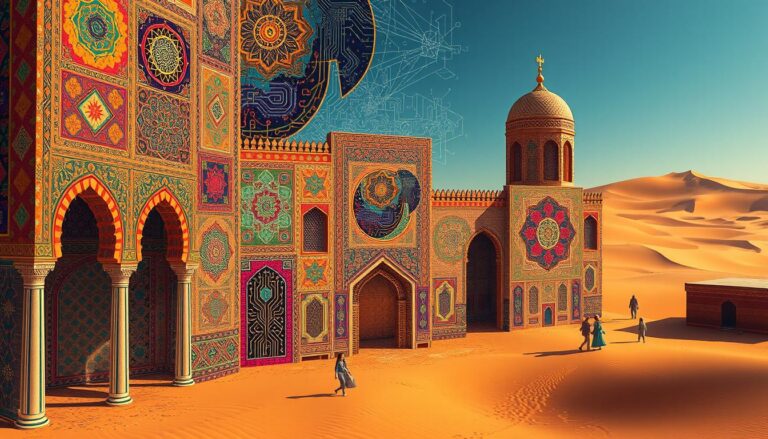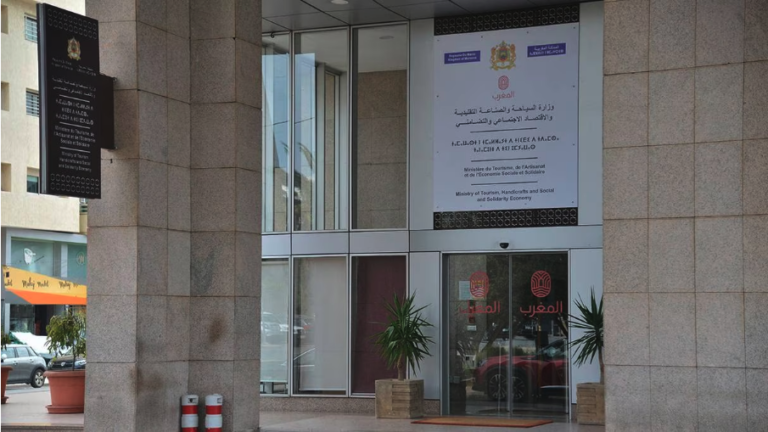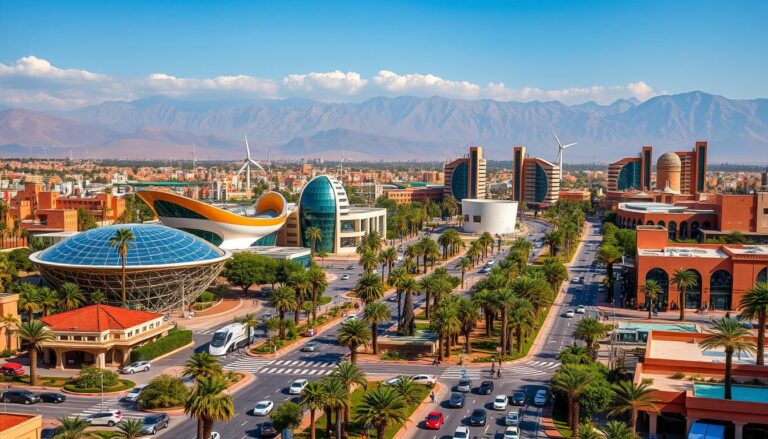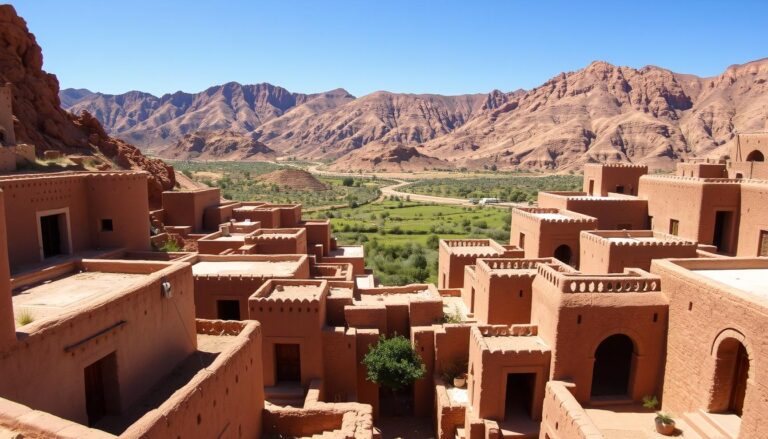How is Morocco planning to bridge its $37 billion infrastructure investment gap by 2040 while transitioning towards renewable energy?
Morocco is known for leading in infrastructure in Africa. It faces a huge challenge with a $37 billion investment gap by 2040. The country plans to invest in roads, ports, airports, and rail links, with $4 billion set aside for these projects.
Morocco is focusing on renewable energy, aiming for 56% of its investments. It also plans to invest in transportation (21%) and oil and gas (19%). The country has big plans, like the 2040 Rail Strategy and the Noor Ouarzazate solar project.
Morocco wants to host the FIFA World Cup 2030 with Spain and Portugal. This will boost sports and transportation infrastructure. The country is using state-owned enterprises and public-private partnerships to grow. Its vision is for sustainable and diversified growth.
Overview of Morocco’s Infrastructure Initiatives
Morocco is working hard to improve its infrastructure. It needs to invest $37 billion by 2040. The government has big plans to meet this challenge.
Investment Gap and Future Plans
The Global Infrastructure Hub says Morocco needs $37 billion by 2040. To close this gap, Morocco plans to invest a lot. So far, it has invested $4 billion, with:
- 56% in energy,
- 21% in transportation, and
- 19% in oil and gas.
Morocco wants to build a lot of roads. It aims to create 2,100 miles of expressways and 1,300 miles of highways by 2030. This will cost about $9.6 billion. The government also plans to spend nearly $7.5 billion to improve ports by 2030.
By 2023, the National Ports Authority will spend nearly $600 million. This shows Morocco’s long-term vision.
Sector-Based Infrastructure Plans
Morocco has big plans for different sectors. The 2040 Rail Strategy aims to spend $37 billion on rail projects. This will add to the 800 miles of track already in place.
Casablanca is investing $1.6 billion in two new tram lines. This shows the focus on transportation.
Renewable energy is key for Morocco. It aims to get 52% of its energy from renewables by 2030. This is up from the original goal of 42%. Morocco is leading in renewable energy projects.
Morocco’s plans cover roads, rails, ports, and energy. These projects are part of a bigger plan to improve the country. The government wants to make Morocco a key player in infrastructure.
Road Development Projects in Morocco
The Moroccan Ministry of Transport and Logistics is leading big projects to improve the country’s roads. They plan to add 2,100 miles of expressways and 1,300 miles of highways by 2030. This will make Morocco a key player in African transport.
Despite needing $34 billion for roads, the planning is smart. It promises better connections and economic growth.
Expansion of Expressways
Expanding expressways is a big part of Morocco’s road plans. They aim to extend the highway network to 3,000 kilometers. This will link major cities and boost regional ties.
The government is serious about improving roads. They spend about 1.25 billion dirhams each year on local road repairs. New expressway projects will connect Guercif to Nador and Casablanca to Berrechid.
Highway Development
Highway development is key to solving Morocco’s geographical and social issues. The ministry wants to build roads that meet different regional needs. This will help isolated areas join the national economy.
They are also focusing on road safety. They’ve identified 340 accident-prone spots, with 15 fixed in 2023. These projects aim to create strong economic connections and growth for all.
Railway Expansion and 2040 Rail Strategy
Morocco is working on a big plan to expand its railways by 2040. They want to grow the high-speed rail network from 200 miles to 800 miles. The Al Boraq line, which runs between Tangier and Casablanca, is a key part of this effort.
Al Boraq makes traveling faster, cutting the time from five hours to just two. This is much quicker than regular trains.
The National Railway Office (ONCF) is leading these efforts. They aim to connect more cities and improve rail services. This will help the economy grow.
ONCF plans to add 2,300 miles of rail lines. They want to link 43 cities, up from 23 now. This will benefit 87% of the population, compared to 51% now.
High-Speed Rail Projects
One big project is extending the Tanger-Casablanca line to Marrakesh. They also plan to reach Agadir and Laayoune in the future. This will make traveling between cities much faster.
There are also talks about building an underwater rail tunnel to Europe. This would be a huge step for international travel and trade.
Conventional Rail Line Extensions
Regular rail services will also get a boost. They plan to create 300,000 jobs and connect 12 ports and 15 airports. This will help the economy grow.
A $8 billion investment will extend the railway from Laayoune to Agadir. This will help the southern regions develop faster.
The development model in Laayoune since 2015 has already made a difference. It includes new roads, ports, and better education and healthcare. The railways will bring more jobs and investment to the south.
In summary, Morocco’s 2040 Rail Strategy is a big step forward. It aims to cover the whole country with railways. This will improve transportation and boost the economy.
Urban Development: Zenata Eco-City Project
The Zenata Eco-City project is a key example of urban development in Morocco. It shows the country’s dedication to sustainable growth. Located near Casablanca, it covers 1,830 hectares of coastal land. It’s designed to handle population growth while keeping the environment and economy in balance.
Officially declared a “public utility project” by royal decree in 2006, Zenata aims to be a center for education, healthcare, and commerce.
Morocco is among the most active in building new cities since the late 1990s. It has 19 new city projects underway, with Zenata Eco-City leading the way. Over 150 new cities have been built in 40 countries, showing a global trend towards fast development.
The Zenata project plans to create 100,000 jobs and house 300,000 people in 30 years. It will have commercial centers, educational institutions, healthcare facilities, and more. This comprehensive development will make the city more attractive and functional.
Greater Casablanca, with 4.25 million people, has seen rapid economic growth. This has led to a rural exodus and uncontrolled urbanization. Zenata aims to manage climate change and enhance cooling through wind flows. It will have 30% of its area as public parks, promoting biodiversity and cooling.
This project reflects Morocco’s ambitions in urban development and serves as a model for others. The developers claim to have found a way to build sustainable and economically viable cities. They are working with African countries to achieve this.
The European Investment Bank (EIB) has agreed to lend up to €150 million for the project. The total cost is estimated at €800 million. However, the project faces challenges, including the resettlement of over 40,000 people. This has raised concerns about eligibility and compensation standards.
The urban development in Morocco is marked by initiatives like Zenata Eco-City. It shows a balanced approach to modernizing infrastructure while focusing on environmental and social well-being. Morocco is setting a precedent in creating sustainable, inclusive urban spaces.
Ports and Maritime Projects
Morocco is investing heavily in its maritime infrastructure. This shows its commitment through big projects. A key part of these efforts is the 2030 National Port Strategy. It aims to modernize and strengthen port facilities.
2030 National Port Strategy
The 2030 National Port Strategy plans to spend $7.5 billion on 27 commercial ports. This shows Morocco’s effort to close the investment gap and ensure economic stability. The goal is to increase port throughput to 290 to 370 million tonnes by 2030.
New Projects: Dakhla Atlantic Port
The Dakhla Atlantic Port is a major project in Morocco. It’s a $1.2 billion investment that will be finished by 2028. It will cover 1,650 hectares and handle 35 million tons of goods yearly.
This port is crucial for the Sahel region. It will greatly benefit countries like Mali, Chad, Niger, and Burkina Faso. It will improve their access to global markets.
Logistics Ecosystem: TangerMed
TangerMed Port is at the center of Morocco’s logistics ecosystem. It’s a key example of Morocco’s maritime progress. Since it started, TangerMed has become the largest port in the Mediterranean.
It has grown a lot over the last 20 years. This growth has been supported by over 700 million euros in investment. The port sector has seen steady growth, with a 6% increase in trade each year.
Solar and Wind Energy Projects
Morocco is making big steps towards using renewable energy. It’s investing a lot in Morocco infrastructure investment to cut down on carbon emissions. The country wants to be energy independent using green sources. Solar and wind energy projects are key to Morocco’s green future.
Noor Ouarzazate Solar Complex
The Noor Ouarzazate Solar Complex is a big deal for Morocco’s green goals. It’s expected to have about 580 MW of power. This project is a huge step in reducing carbon emissions and shows the power of solar energy.
Started in 2016, Noor Ouarzazate aims to provide clean energy even when it’s not sunny. It’s a big part of Morocco’s power supply. Future phases will add even more to the country’s electricity grid.
Tarfaya Wind Farm
Morocco is also big on wind energy. The Tarfaya Wind Farm is one of Africa’s biggest. It’s part of Morocco’s plan to get 52% of its energy from renewables by 2030.
This wind farm is not just about energy. It also creates jobs and helps diversify the economy. It’s a big win for sustainable energy and the local community.
Dakhla Wind Farm Project
The Dakhla Wind Farm Project is another big step for Morocco. It combines renewable energy with cutting-edge technology. The project uses blockchain to make energy distribution and trading more efficient.
Blockchain helps make sure everything runs smoothly and fairly. The Dakhla Wind Farm is a key part of Morocco’s long-term Morocco infrastructure investment plan. It shows the country’s commitment to a sustainable future.
Ambitious Construction Projects: Mohammed VI Tower
The Mohammed VI Tower is a modern marvel in Morocco. It stands tall at 250 meters with 55 floors in Rabat. It’s the tallest building in Africa, showing Morocco’s commitment to building projects.
Morocco construction projects aim to make the country’s architecture stand out. The Mohammed VI Tower is a prime example. It’s built to last, with safety in mind. Its height makes it a key landmark in Rabat.
The tower offers top-notch amenities for luxury and ease. It shows a mix of practicality and elegance. This design makes the tower appealing and reflects Morocco’s focus on quality and innovation.
The Mohammed VI Tower is part of a bigger plan to improve Morocco’s infrastructure. The country is also working on high-speed railways, sports stadiums, and urban plans. These projects aim to make Morocco a leader in construction and infrastructure.
Significant Transportation Projects
Morocco is becoming a key player in transportation, thanks to its focus on building better infrastructure. The country is working hard on rail and tunnel projects. These efforts aim to improve travel within Morocco and beyond.
Casablanca to Marrakech High-Speed Rail
The high-speed rail from Casablanca to Marrakech is a big deal for Morocco. It’s designed to make traveling between these two cities faster. The plan is to extend it to Agadir, making travel even quicker.
Morocco is putting a lot of money and effort into these projects. They want to make fast, safe, and efficient rail travel a reality. This will also help the economy grow by boosting business.
Strait of Gibraltar Underwater Tunnel
The Strait of Gibraltar underwater tunnel project is just as ambitious. It aims to connect Morocco to Spain. This project will make traveling between Africa and Europe easier.
This tunnel will be a big step for Morocco, making it a key transportation hub. It will help tourism and trade between Europe and Africa. Morocco’s projects show their commitment to better travel and sustainable development.
Conclusion
Morocco’s Infrastructure Mega Projects show the country’s smart planning and focus on top-notch infrastructure. These projects cover many areas like roads, railways, and energy. They aim to change Morocco’s economy and make it a key player worldwide.
The country is making big strides in road transport infrastructure and renewable energy. For example, the Noor Ouarzazate Solar Complex is a leader in solar power. Morocco plans to use more renewable energy, with $13 billion for wind, solar, and hydroelectric power.
Projects like the Mohammed VI Tower show Morocco’s drive for modernity. In transport, the Casablanca to Marrakech High-Speed Rail and the Strait of Gibraltar Underwater Tunnel are opening up new paths. The National Ports Strategy 2030 and TangerMed port modernization are also key, making Morocco a major trade center.
These projects show Morocco’s commitment to growth and improving its infrastructure. They are designed for long-term success and sustainable development.
Source Links
- Top Mega Projects in Morocco, North Africa
- Morocco Projects – Meed Projects
- Morocco Construction Industry Report 2024: Output to Grow at an AAGR of 3.7% During 2025-2028, Supported by Investments in Rail Transportation, Water Infrastructure, and Energy Sectors
- Morocco – Infrastructure
- Morocco’s Long Road Toward Economic Transformation
- World Bank Document
- Transforming Morocco: Nizar Baraka’s Infrastructure Vision For 2030 And Beyond – OpEd
- Morocco’s Rural Roads Program | Inequality Solutions Portal
- 2040 plan for Africa’s only high-speed rail line
- Morocco eyes massive railway expansion reaching the Sahara
- Building the first eco-city in Morocco
- Zenata Urban Development
- ‘We’re constructing an ecosystem’: How a small, windy city could become a gateway for trade | CNN
- This is Morocco’s port strategy for 2030
- Harnessing the Sun and Wind: Morocco’s Renewable Energy Revolution
- A shining example of green energy in Morocco
- A Strategic Partnership For Morocco’s Water and Infrastructure Development – OpEd
- Large-scale infrastructure projects in Tangiers transforming and diversifying Morocco – Africa 2018 – Oxford Business Group
- Morocco Expedites Rabat Infrastructure Projects for 2030 FIFA World Cup
- Infrastructure, Construction and Transport | DLA Piper | Maroc
- Projects – Arab Urban Development Institute
- Why Morocco is a Key Player in China’s Belt and Road Initiative — The Fletcher Forum of World Affairs
- French Magazine highlights Morocco’s Infrastructure Renaissance spearheaded by King Mohammed VI

The Editorial Team is a passionate group of Morocco enthusiasts dedicated to sharing the beauty, culture, and wonders of this captivating country. With diverse backgrounds and a deep love for travel, we strive to bring you engaging and informative content that inspires your Moroccan adventures. From uncovering hidden gems and sharing local insights to exploring mouthwatering cuisine and showcasing the vibrant lifestyle, our team is committed to providing you with valuable resources and exciting stories that enhance your exploration of Morocco. Join us on this journey as we celebrate the rich heritage and unforgettable experiences that make Morocco truly special.

